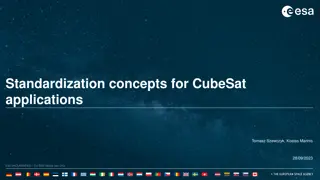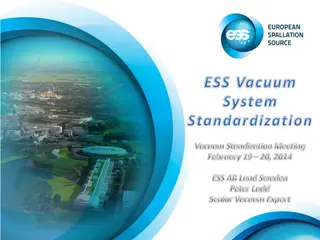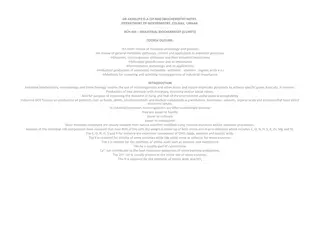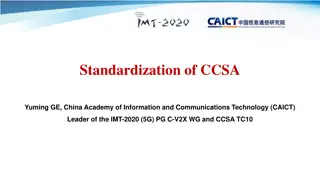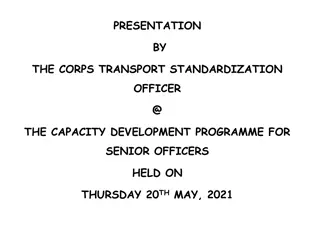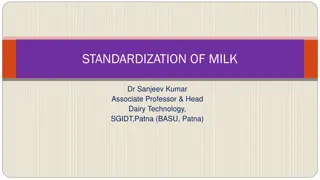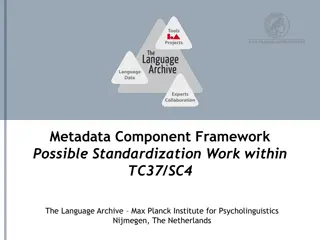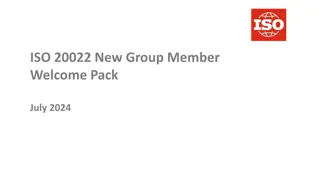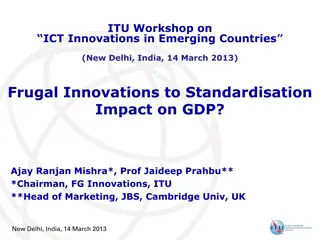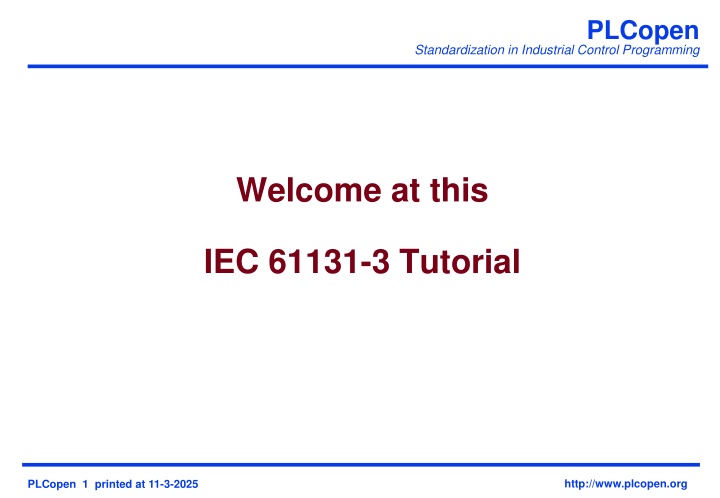
PLCopen Standardization in Industrial Control Programming
PLCopen is a standardization initiative aimed at harmonizing industrial control programming, making it easier for engineers to work with different control systems. The goal is to reduce complexity and improve efficiency in industrial automation. With a focus on IEC 61131-3 standards, PLCopen provides guidelines for hardware, programming languages, user interfaces, and more. By adopting these standards, businesses can enhance their control systems and stay competitive in the market.
Download Presentation

Please find below an Image/Link to download the presentation.
The content on the website is provided AS IS for your information and personal use only. It may not be sold, licensed, or shared on other websites without obtaining consent from the author. If you encounter any issues during the download, it is possible that the publisher has removed the file from their server.
You are allowed to download the files provided on this website for personal or commercial use, subject to the condition that they are used lawfully. All files are the property of their respective owners.
The content on the website is provided AS IS for your information and personal use only. It may not be sold, licensed, or shared on other websites without obtaining consent from the author.
E N D
Presentation Transcript
PLCopen Standardization in Industrial Control Programming Welcome at this IEC 61131-3 Tutorial http://www.plcopen.org PLCopen 1 printed at 11-3-2025
PLCopen Standardization in Industrial Control Programming Harmonizing the way people look to control the future is here Eelco van der Wal Managing Director PLCopen http://www.plcopen.org PLCopen 2 printed at 11-3-2025
PLCopen Standardization in Industrial Control Programming Fiction? Imagine * you are in industrial control * working with 4 different brands of controls * using different dialects in their programming languages * strugling to match the level of your software engineers with the electrical engineers / maintenance on the factory floor * & seeing that your competitor does better Why? What s wrong ? http://www.plcopen.org PLCopen 3 printed at 11-3-2025
PLCopen Standardization in Industrial Control Programming Out of the jungle The current variety of problems can be vastly reduced via standardization ... and such a standard is available http://www.plcopen.org PLCopen 4 printed at 11-3-2025
PLCopen Standardization in Industrial Control Programming IEC 61131-3 The best thing that happened to industrial control Sugar Lantic on Automation Maillist http://www.plcopen.org PLCopen 5 printed at 11-3-2025
PLCopen Standardization in Industrial Control Programming The 7 parts of the IEC 61131 Standard - 1 General overview, definitions - 2 Hardware - 3 Programming Languages - 4 User Guidelines - 5 Messaging Service Specification - 7 Fuzzy Logic - 8 Implementation guidelines http://www.plcopen.org PLCopen 6 printed at 11-3-2025
PLCopen Standardization in Industrial Control Programming IEC 61131-3 Programming languages / Industrial Control Programming The interface between the programmer and the control system http://www.plcopen.org PLCopen 7 printed at 11-3-2025
PLCopen Standardization in Industrial Control Programming IEC 61131-3 Programming languages / Industrial Control Programming ...with support for people with different backgrounds http://www.plcopen.org PLCopen 8 printed at 11-3-2025
PLCopen Standardization in Industrial Control Programming What is the Benefit of such a Standard ? http://www.plcopen.org PLCopen 9 printed at 11-3-2025
PLCopen Standardization in Industrial Control Programming Users? Which Users? Discrete Mnf Process cntrl System Integrator YOU ?? Education Programming Maintenance Installation http://www.plcopen.org PLCopen 10 printed at 11-3-2025
PLCopen Standardization in Industrial Control Programming Users? Which Users? Automobile production lines Water treatment plant Food processing and packaging machinery Cable manufacturing Semi-conductor clean room automation Theme-park roller coasters Nuclear waste treatment plant This wide range encompass different skills http://www.plcopen.org PLCopen 11 printed at 11-3-2025
PLCopen Standardization in Industrial Control Programming What is the Benefit of such a Standard Reduced waste of human resources (in training, debugging, maintenance and consultancy) http://www.plcopen.org PLCopen 12 printed at 11-3-2025
PLCopen Standardization in Industrial Control Programming What is the Benefit of such a Standard Reduced waste of human resources (in training, debugging, maintenance and consultancy) Creating a focus to problem solving via software re-usability (reduced application investment and supplier dependency) http://www.plcopen.org PLCopen 13 printed at 11-3-2025
PLCopen Standardization in Industrial Control Programming What is the Benefit of such a Standard Reduced waste of human resources (in training, debugging, maintenance and consultancy) Creating a focus to problem solving via software re-usability (reduced application investment and supplier dependency) Reduced misunderstandings and errors http://www.plcopen.org PLCopen 14 printed at 11-3-2025
PLCopen Standardization in Industrial Control Programming What is the Benefit of such a Standard Reduced waste of human resources (in training, debugging, maintenance and consultancy) Creating a focus to problem solving via software re-usability (reduced application investment and supplier dependency) Reduced misunderstandings and errors Programming techniques usable in more environments (general industrial control) http://www.plcopen.org PLCopen 15 printed at 11-3-2025
PLCopen Standardization in Industrial Control Programming What is the Benefit of such a Standard Reduced waste of human resources (in training, debugging, maintenance and consultancy) Creating a focus to problem solving via software re-usability (reduced application investment and supplier dependency) Reduced misunderstandings and errors Programming techniques usable in more environments (general industrial control) Combining harmonously different components from different locations, companies or countries, or projects http://www.plcopen.org PLCopen 16 printed at 11-3-2025
PLCopen Standardization in Industrial Control Programming What is the Benefit of such a Standard Reduced waste of human resources (in training, debugging, maintenance and consultancy) Creating a focus to problem solving via software re-usability (reduced application investment and supplier dependency) Reduced misunderstandings and errors Programming techniques usable in more environments (general industrial control) Combining harmonously different components from different locations, companies or countries, or projects Increased connectivity (investment protection) http://www.plcopen.org PLCopen 17 printed at 11-3-2025
PLCopen Standardization in Industrial Control Programming What is the Benefit of such a Standard Reduced waste of human resources (in training, debugging, maintenance and consultancy) Creating a focus to problem solving via software re-usability (reduced application investment and supplier dependency) Reduced misunderstandings and errors Programming techniques usable in more environments (general industrial control) Combining harmonously different components from different locations, companies or countries, or projects Increased connectivity (investment protection) Software Library Function Block "Heating" Function "LIMIT" Function Block "Feeding" Function "TEST" Function Block "Turning" http://www.plcopen.org PLCopen 18 printed at 11-3-2025
PLCopen Standardization in Industrial Control Programming Key quality features of IEC 61131-3 Structured software - through use of Configuration, Resource and Program Organization Units (POUs) Strong Data Typing - through languages that restrict operations to only apply to appropriate types of data Execution control - through use of tasks Complex sequential behaviour - through Sequential Function Charts Software encapsulation - through use of POUs, structures and complex data types. http://www.plcopen.org PLCopen 19 printed at 11-3-2025
PLCopen Standardization in Industrial Control Programming An example Fermentation Control System courtesy of Omron Electronics http://www.plcopen.org PLCopen 20 printed at 11-3-2025
PLCopen Standardization in Industrial Control Programming Fermentation Process Agitator Feed valve Acidic reagent Alkali reagent Temperature sensor pH sensor Heater band Harvest valve http://www.plcopen.org PLCopen 21 printed at 11-3-2025
PLCopen Standardization in Industrial Control Programming Fermentation control decomposition MainSequence e.g. top level process steps - filling, heating, agitating, fermenting, harvesting, cleaning. Valve control e.g. operating valves used to fill and empty the fermentation vessel Temperature control for monitoring the temperature of the vessel and modulating the heater. Agitator control for the agitator motor activated as demanded by the main process sequence. pH Control for monitoring the acidity of the fermentation contents and adding acidic or alkali reagents. http://www.plcopen.org PLCopen 22 printed at 11-3-2025
PLCopen Standardization in Industrial Control Programming Fermentation control program TempControl Heat Heat Cool SetPoint TempSensor Cool PV pHSensor pHControl AddAcid MainSequence AddAcid SetPoint AddAlkali Start AddAlkali Temp PV Start Stop Stop pH Duration AgitateControl Agitation Duration MotorSpeed FillState MotorSpeed SetPoint PV AgitateSpeed ValveControl Fill Fill State ValvePositions Harvest Harvest http://www.plcopen.org PLCopen 23 printed at 11-3-2025
PLCopen Standardization in Industrial Control Programming Main sequence SFC S1 N Initialisation S2 N Filling S3 N Heating Shows the main process states S4 N Fermenting S5 N Harvesting S6 N Cleaning http://www.plcopen.org PLCopen 24 printed at 11-3-2025
PLCopen Standardization in Industrial Control Programming IEC 61131-3 Overview http://www.plcopen.org PLCopen 25 printed at 11-3-2025
PLCopen Standardization in Industrial Control Programming The IEC 61131-3 Standard Common Elements Programming Languages http://www.plcopen.org PLCopen 26 printed at 11-3-2025
PLCopen Standardization in Industrial Control Programming The IEC 61131-3 Standard Common Elements Programming Languages http://www.plcopen.org PLCopen 27 printed at 11-3-2025
PLCopen Standardization in Industrial Control Programming The IEC 61131-3 Programming Languages Instruction List LD A Structured Text ANDN B C:= A AND NOT B ST C Function Block Diagram Ladder Diagram AND A B C A C -| |--|/|----------------( ) B http://www.plcopen.org PLCopen 28 printed at 11-3-2025
PLCopen Standardization in Industrial Control Programming The IEC 61131-3 Standard Common Elements Programming Languages http://www.plcopen.org PLCopen 29 printed at 11-3-2025
PLCopen Standardization in Industrial Control Programming Common Elements include : Variables, Data Types and Declaration Configuration, Resources and Tasks Function, Function Blocks and Programs Sequential Function Charts http://www.plcopen.org PLCopen 30 printed at 11-3-2025
PLCopen Standardization in Industrial Control Programming IEC 61131-3 : Common Elements Variables Symbolic representation via labels Restricted area for I/O mapping Hardware independent code What is this? 01010101 10101010 http://www.plcopen.org PLCopen 31 printed at 11-3-2025
PLCopen Standardization in Industrial Control Programming IEC 61131-3 : Common Elements Data Types such as: BOOL INTEGER : SINT, INT, DINT, LINT USINT, UINT, UDINT, ULINT REAL, LREAL DATE TIME_OF_DAY DATE_AND_TIME STRING BYTE http://www.plcopen.org PLCopen 32 printed at 11-3-2025
PLCopen Standardization in Industrial Control Programming Variable Declaration textual representation of usage type of variable scope: local (or global) explicit parameter passing via variables (inputs or outputs) memory allocation declaration can include initial values coupled to Program Organization Unit (Function, Function Block or Program) http://www.plcopen.org PLCopen 33 printed at 11-3-2025
PLCopen Standardization in Industrial Control Programming Variable Declarations Variable usage Keyword VAR VAR_INPUT VAR_OUTPUT VAR_IN_OUT VAR_EXTERNAL VAR_GLOBAL VAR_ACCESS RETAIN CONSTANT AT Internal to organization unit Externally supplied, not modifiable within organization unit Supplied by organization unit to external entities Supplied by external entities. Can be modified within org. unit Supplied by configuration via VAR_GLOBAL .Can be modified within organization unit Global variable declaration Access path declaration Retentive variables Constant (variable cannot be modified) Location assignment http://www.plcopen.org PLCopen 34 printed at 11-3-2025
PLCopen Standardization in Industrial Control Programming Variable Declarations : example VAR CONDITION_RED : BOOL; IBOUNCE : WORD; MYDUB : DWORD; AWORD, BWORD, CWORD: INT; OKAY : STRING[10] := OK ; END_VAR http://www.plcopen.org PLCopen 35 printed at 11-3-2025
PLCopen Standardization in Industrial Control Programming IEC 61131-3 : Common Elements Data Types & Variables in addition: Your own datatypes derived datatypes http://www.plcopen.org PLCopen 36 printed at 11-3-2025
PLCopen Standardization in Industrial Control Programming Derived Datatypes Direct derivation from elementary types, e.g.: TYPE R : REAL ; END_TYPE Enumerated data types, e.g.: TYPE ANALOG_SIGNAL_TYPE : (SINGLE_ENDED, DIFFERENTIAL) ; END_TYPE Subrange data types, e.g.: TYPE ANALOG_DATA : INT (-4095..4095) ; END_TYPE Array data types, e.g.: TYPE ANALOG_16_INPUT_DATA : ARRAY [1..16] OF ANALOG_DATA ; END_TYPE http://www.plcopen.org PLCopen 37 printed at 11-3-2025
PLCopen Standardization in Industrial Control Programming Your own datatype: derived datatype TYPE ANALOG_CHANNEL_CONFIGURATION : STRUCT RANGE : ANALOG_SIGNAL_RANGE ; MIN_SCALE : ANALOG_DATA ; MAX_SCALE : ANALOG_DATA ; END_STRUCT ; ANALOG_16_INPUT_CONFIGURATION : STRUCT SIGNAL_TYPE : ANALOG_SIGNAL_TYPE ; FILTER_PARAMETER : SINT (0..99) ; CHANNEL : ARRAY [1..16] OF ANALOG_CHANNEL_CONFIGURATION ; END_STRUCT ; END_TYPE http://www.plcopen.org PLCopen 38 printed at 11-3-2025
PLCopen Standardization in Industrial Control Programming Your own datatype: derived datatype TYPE ANALOG_CHANNEL_CONFIGURATION : STRUCT RANGE : ANALOG_SIGNAL_RANGE ; MIN_SCALE : ANALOG_DATA ; MAX_SCALE : ANALOG_DATA ; END_STRUCT ; TYPE ANALOG_DATA : INT (-4095..4095) ; END_TYPE ANALOG_16_INPUT_CONFIGURATION : STRUCT SIGNAL_TYPE : ANALOG_SIGNAL_TYPE ; FILTER_PARAMETER : SINT (0..99) ; CHANNEL : ARRAY [1..16] OF ANALOG_CHANNEL_CONFIGURATION ; END_STRUCT ; END_TYPE http://www.plcopen.org PLCopen 39 printed at 11-3-2025
PLCopen Standardization in Industrial Control Programming Your own datatype: derived datatype TYPE ANALOG_CHANNEL_CONFIGURATION : STRUCT RANGE : ANALOG_SIGNAL_RANGE ; MIN_SCALE : ANALOG_DATA ; MAX_SCALE : ANALOG_DATA ; END_STRUCT ; ANALOG_16_INPUT_CONFIGURATION : STRUCT SIGNAL_TYPE : ANALOG_SIGNAL_TYPE ; FILTER_PARAMETER : SINT (0..99) ; CHANNEL : ARRAY [1..16] OF ANALOG_CHANNEL_CONFIGURATION ; END_STRUCT ; END_TYPE TYPE ANALOG_SIGNAL_TYPE : (SINGLE_ENDED, DIFFERENTIAL) ; END_TYPE http://www.plcopen.org PLCopen 40 printed at 11-3-2025
PLCopen Standardization in Industrial Control Programming Directly Represented Variables : % Prefix Meaning Default data type I Q M X None B W D L Input location Output location Memory location Single bit size Single bit size Byte (8 bits) size Word (16 bits) size Double word (32 bits) size Long (quad) word (64 bits) size BOOL BOOL BYTE WORD DWORD LWORD http://www.plcopen.org PLCopen 41 printed at 11-3-2025
PLCopen Standardization in Industrial Control Programming IEC 61131-3 : Common Elements COMMON ELEMENTS a.o. Data Types & Variables Configuration Resources Tasks http://www.plcopen.org PLCopen 42 printed at 11-3-2025
PLCopen Standardization in Industrial Control Programming IEC 61131-3 Software Model Configuration Communication Function http://www.plcopen.org PLCopen 43 printed at 11-3-2025
PLCopen Standardization in Industrial Control Programming IEC 61131-3 Software Model Configuration Resource Resource Communication Function http://www.plcopen.org PLCopen 44 printed at 11-3-2025
PLCopen Standardization in Industrial Control Programming IEC 61131-3 Software Model Configuration Resource Resource Task Task Task Task Communication Function http://www.plcopen.org PLCopen 45 printed at 11-3-2025
PLCopen Standardization in Industrial Control Programming IEC 61131-3 Software Model Configuration Resource Resource Task Task Task Task Program Program Program Program Execution control path Communication Function http://www.plcopen.org PLCopen 46 printed at 11-3-2025
PLCopen Standardization in Industrial Control Programming IEC 61131-3 Software Model Configuration Resource Resource FB Task Task Task Task Function Block Program Program FB Program Program FB FB FB Execution control path Access path Communication Function http://www.plcopen.org PLCopen 47 printed at 11-3-2025
PLCopen Standardization in Industrial Control Programming IEC 61131-3 Software Model Configuration Variable access path Resource Resource FB Task Task Task Task Function Block Program Program FB Program Program FB Variable FB FB Global and direct variables Execution control path Access path Communication Function http://www.plcopen.org PLCopen 48 printed at 11-3-2025
PLCopen Standardization in Industrial Control Programming IEC 61131-3 vs conventional PLC Configuration Variable access path Resource Resource FB Task Task Task Task Function Block Program Program FB Program Program FB Variable FB FB Global and direct variables Execution control path Access path Communication Function http://www.plcopen.org PLCopen 49 printed at 11-3-2025
PLCopen Standardization in Industrial Control Programming Configuration Elements Configuration Resources Tasks Global Variables Access Paths http://www.plcopen.org PLCopen 50 printed at 11-3-2025


